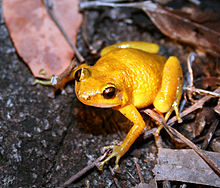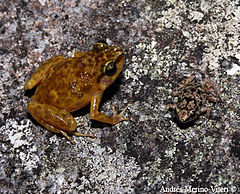- Black Mountain Boulder Frog
-
Black Mountain Boulder Frog 
Female of Black Mountain Boulder Frog (Cophixalus saxatilis) Conservation status Scientific classification Kingdom: Animalia Phylum: Chordata Class: Amphibia Order: Anura Family: Microhylidae Genus: Cophixalus Species: C. saxatilis Binomial name Cophixalus saxatilis
Zweifel & Parker, 1977The Black Mountain Boulder Frog (aka Rock Haunting Frog) (Cophixalus saxatilis) is a species of frog in the Microhylidae family.
It is endemic to Australia, and its populations are now restricted to the Black Mountain (Kalkajaka) National Park, Australia[1].
Its original habitats were subtropical or tropical moist lowland forests, rocky areas, and caves, now severely reduced to the "Black Mountains" 25 km south-west of Cooktown, Queensland[1]
Contents
Description
The Queensland Environmental Protection Agency has described and summarized some of the distinctive features of this frog as follows:[1]
The vulnerable Black Mountain boulderfrog or rock haunting frog (Cophixalus saxatilis) is the largest (about the size of a walnut) of Australia’s microhylids — a group of frogs normally confined to the leaf litter of tropical rainforests.This large-eyed frog lays its eggs on land rather than in water. An adult tends to the eggs and young, which hatch as fully formed froglets. They have no tadpole stage.
The bright yellow female frog and the smaller mottled brown male are more easily heard than seen. Their call is a sharp tapping noise.
They have acquired an almost crab-like ability to scuttle on the granite boulders, although they can still disappear in a series of leaps when alarmed. At night these frogs emerge to forage on the boulders of the mountain and in and about the scattered figs and fringing monsoon forest.See also
- Black Mountain (Kalkajaka) National Park
References
- ^ a b c Environmental Protection Agency (Qld) "Black Mountain (Kalkajaka) National Park — Nature, culture and history" 24 February 2009
External links
- Alford, R., Cunningham, M., Hoskin, C., McDonald, K. & Retallick, R. 2004. Cophixalus saxatilis. 2006 IUCN Red List of Threatened Species. Downloaded on 23 July 2007.
This Microhylidae article is a stub. You can help Wikipedia by expanding it.


